ASUS G74SX: Noteworthy Updates to ASUS' G7 Series
by Jarred Walton on October 6, 2011 12:00 AM ESTApplication Performance: Add an SSD for Improved Performance
The last-gen G73SW would offer nearly identical performance in our application suite were it not for one thing: the Intel 320 Series SSD in the G74SX. Keep the same processor, improve GPU performance a bit, and add in an SSD and what you get is markedly faster boot and application start times and a smoother overall experience. We’ve mentioned how much Futuremark’s PCMark suites skew towards SSDs, but there’s something to be said for what an SSD can provide. I still feel like it should be more like a 30% improvement in application scores—and you really mostly notice it when launching applications or booting, particularly if you launch multiple applications at once or have half a dozen startup programs. We’ll start with the PCMark suites before moving into CPU-limited testing.
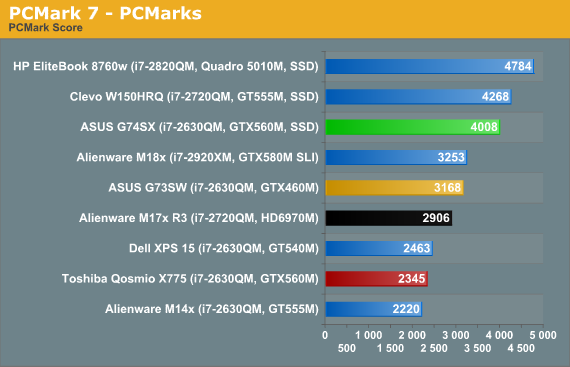
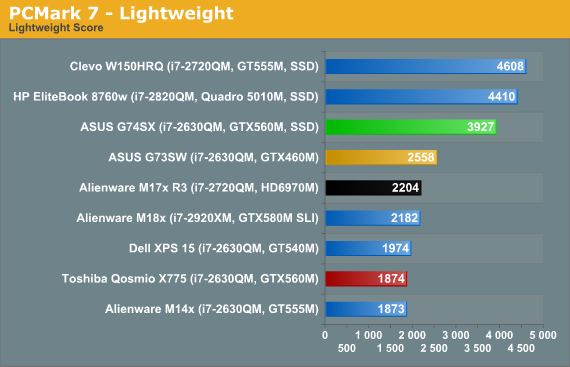
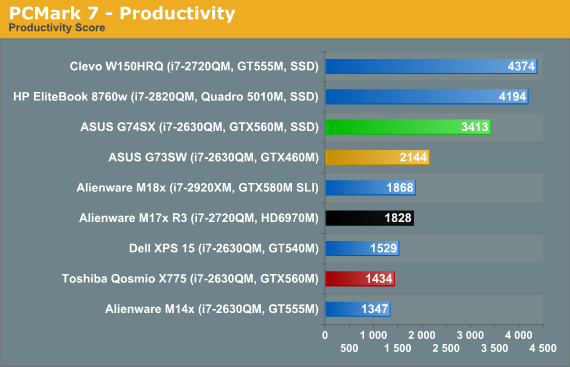
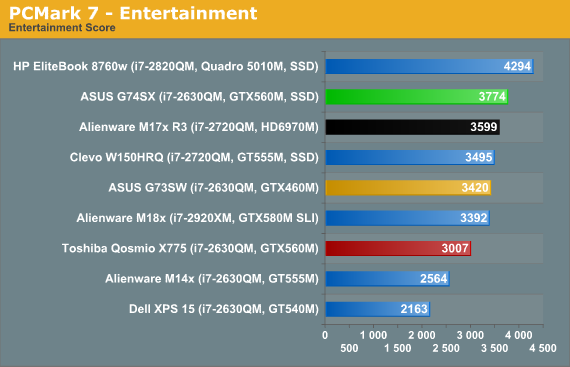
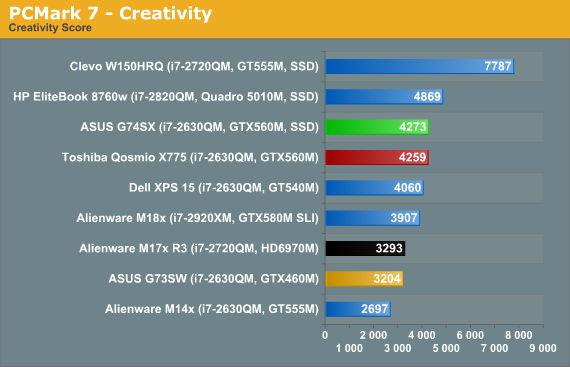

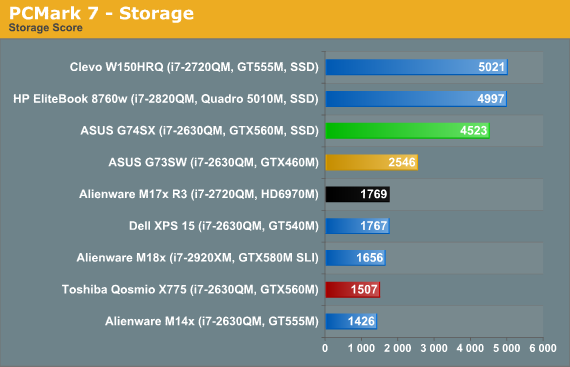

So I just said that I felt the overall benefit to general performance from an SSD should be around 30%, and for the overall PCMark 7 suite that’s exactly what we get: the G74SX ends up 27% faster than the G73SW. Elsewhere, the G74SX is anywhere from equal to its predecessor (the Computation score), to 10% faster (Entertainment), to around 30% faster (Creativity), or as much as 50 to 80% faster (Lightweight, Productivity, and Storage). Turning to the older PCMark Vantage, the G74SX tops the G73SW by 42%.
Moving to a slightly different notebook, however, we can see the problem: the G74SX is 38% faster than the Alienware M17x R3 in the overall PCMark 7 suite, even though the Alienware has a faster i7-2720QM processor, and it’s 155% faster in the storage benchmark—and the M17x is sporting RAID 0 750GB HDDs. ASUS has somehow optimized storage performance so that PCMark 7 really favors their notebooks, and the SSD boosts their score by an appropriate ~30%, but the G73SW already outperforms similarly equipped laptops (e.g. the Dell XPS 15) by 28%, likely thanks to storage optimizations.
I can’t really say that any of the individual scores are without merit, but I can say that you shouldn’t expect a 50% boost in gaming performance from adding an SSD—even if you happen to have enough free space on our SSD to hold the games you play. Similarly, video encoding performance and other computationally intensive tasks are still going to hinge on raw CPU speed, and PCMark’s Computation result reflects this (assuming you’re not using Quick Sync, which we’re not on most of these notebooks, the Qosmio, XPS 15, and W150HRQ being the exceptions). Here are the results from the remainder of our application suite, along with a few 3DMark scores, to round out our general performance overview.
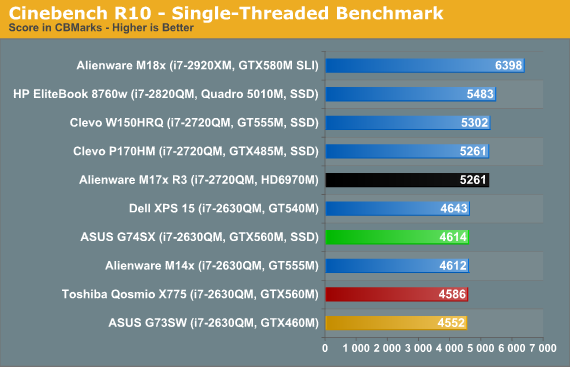
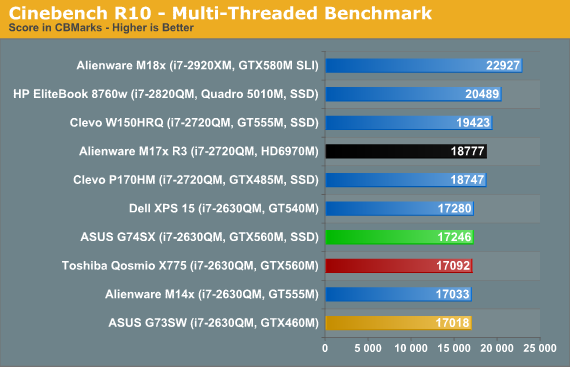
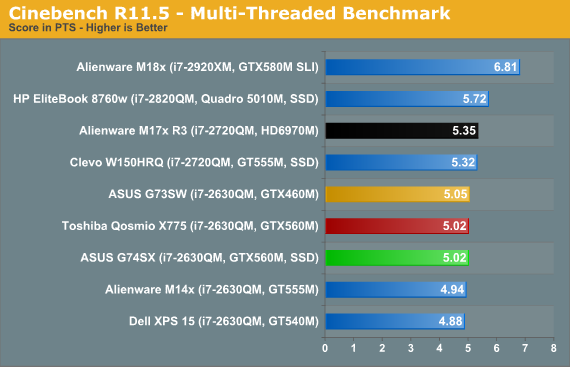
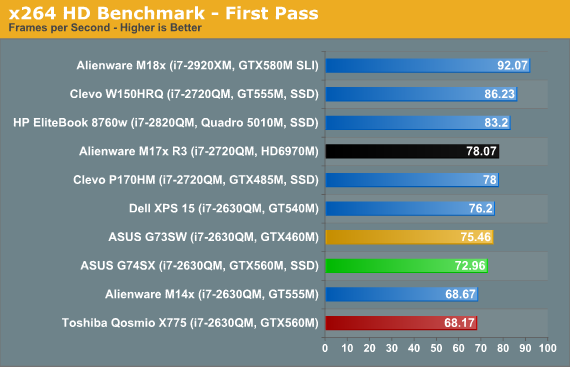
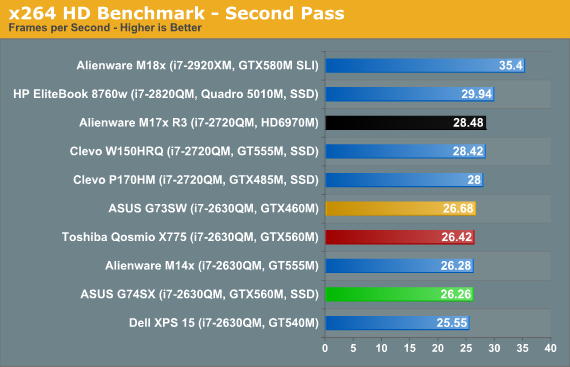

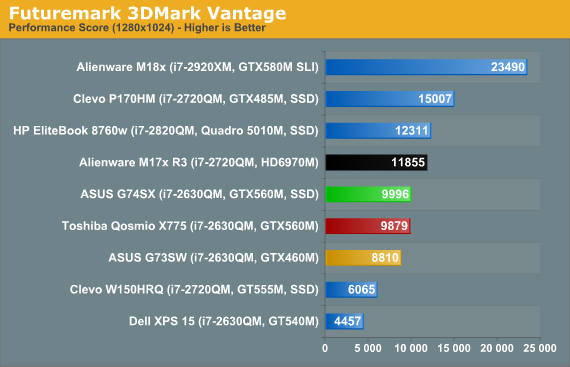
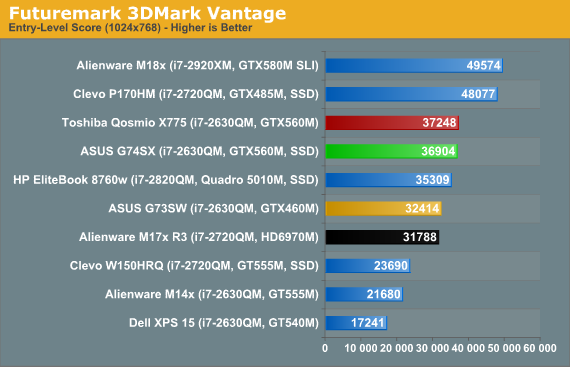
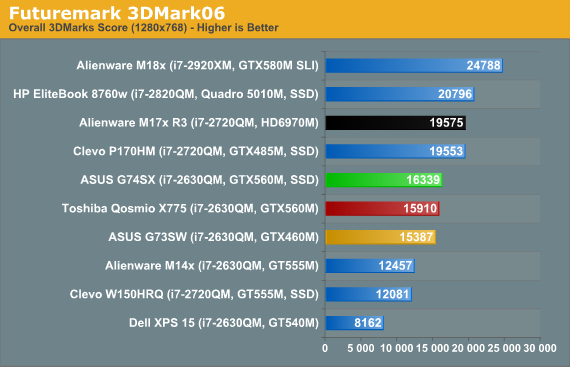
The i7-2630QM is a well-known quantity, and the results fall out right about where we’d expect. There’s some minor variation in performance in the x264 encode first pass, but nothing to worry about. 3DMark gives us our first glimpse of the graphics upgrade the GTX 560M brings to bear, and the results range from 22% faster than the G73SW (3DMark 11) to only 6% faster (3DMark06). We’re also testing with a newer driver release on the G74SX, which may explain the score discrepancy between the ASUS and the Toshiba Qosmio. Optimus may also be a factor, but more likely it’s just drivers. Let’s hit the gaming results next for a full look at graphics performance.










44 Comments
View All Comments
JarredWalton - Thursday, October 6, 2011 - link
AMD's mobile GPUs tend to hit higher temperatures on the high-end in my experience, so that may be part of the equation. Obviously, we don't get to keep these systems long-term, so unfortunately I can't say how any of these will hold up after six months or a year of use. On the plus side, if you do change your thermal paste out, you can use something better that won't need to be replaced a second time.Coup27 - Thursday, October 6, 2011 - link
Am I the only one who is confused by the single USB3 port? I am assuming they used a controller such as NEC which supports two ports, so why did they only use 1?Wolfpup - Friday, October 7, 2011 - link
Yeah, no Intel chipsets support USB 3.0 until next year (I guess it's finally coming next year).Can't remember what chip it uses, but it's worked fine for me (the port is blue, so you can tell the difference).
I'd guess maybe it's harder to wire it up to two ports, or maybe they didn't want to reduce the available ports to only 2 if you're not using Windows 7 (or don't have the drivers installed).
Like the port doesn't work until you get the drivers on there (hopefully Windows 8, or whatever they call 6.2 will just support it out of the box).
I've got a Tripp Lite USB 3.0 hub which seems to work well, and my two external USB 3.0 drives (that I happened to already have) hooked in to that.
I love USB 3.0 so far! I mean 2.0 gets the job done for me, but of course maxes out around 25MB/s-ish, while the same drive under 3.0 seemed to be averaging 95MB/s-ish (and sometimes even higher), which is not something I'll complain about!
hrbngr - Thursday, October 6, 2011 - link
Jarred,I have read you mentioning your RSI issues in several articles. The MS keyboard is a nice option, but you really owe it to yourself to try out a kinesis ergo keyboard:
http://www.kinesis-ergo.com/advantage_pro.htm
It has a USB connection and comes w/a foot pedal that is usually programmed to be the shift key, it only needs a separate numeric keypad--the built in one is kind of clunky--if you use that a lot. I'm not sure I could live w/out mine. Individual key wells and a focus on using both thumbs for the shift/alt/control/tab keys vs using your pinky really work--and I didn't take as long to get used to it as I thought I would.
Great laptop review as btw. However I think that I will wait for the next gen chipset as the on-board video seems to be a substantial upgrade, and when used in Optimus mode, would be good for most all work but heavy gaming.
666 - Thursday, October 6, 2011 - link
Those horrendously overpriced weird keyboardlike things are not selling that well, are they? Perhaps it's the color? :)hrbngr - Friday, October 7, 2011 - link
666,I suppose the white color is a little off-putting, but I did buy the black usb model! :-) They are very overpriced, but there is no other keyboard on the market that come close to it in terms of comfort--especially through the use off the foot pedal for the "shift" key.
Wolfpup - Friday, October 7, 2011 - link
And I really like it. I agree with everything in the review except the (continued) obsession with switchable graphics. A big factor in my purchase of the G74 over other models is that it DOESN'T use switchable graphics. No driver weirdness. No reduced performance. If I'm buying something mid range or high end and it's got a GPU, I want to use the GPU. Power gating and whatnot to get power levels down further would be fine, but I'm not compromising on compatibility or performance to get some extra battery life, even if I used the battery, which I never have on a notebook.I find the G74 very portable too, though the bag they included didn't fit it well, and most don't. Targus' "XL" bag works pretty well, and is pretty decent build quality (if not LL Bean quality).
I've found everything in the review (save for the Optimus stuff...) to be dead on. The performance is great. The keyboard's remarkable for a notebook. (And I love finally having a numberpad!) Physically it SEEMS similar to my Macbook Air keyboard, but the buttons on the Air are much more "mushy" and don't have as much travel as the G74 keyboard does.
The cooling's awesome, the noise level is awesome, just as the review says. The screen's great by notebook standards too-looks great, great viewing angles and contrast, etc.). I normally leave it on minimum brightness (and half the time use a 24" external monitor) but I love having the headroom to crank it up if I need to!
Obviously I'd have loved a GTX 570 or 580, but the 560 is getting it done for me, and probably will for a long time, so...that's fine. Mine (the A1 model) comes with 3GB instead of 1.5GB, though I guess that doesn't affect performance today? Hurray for Windows and good hardware...I was running Modern Warfare 2 on my external screen, while leaving Outlook 2010 running on my internal display, all just working flawlessly!
RAM access seems super easy compared with any other notebook I've seen (there's a bit more space than normal, and of course 4 DIMM slots). My only complaint with access is I wish the cable for the second hard drive had a better mechanism attaching it to the motherboard. If you swap drives as I did, I wouldn't disconnect the cable from the board, just disconnect it from the drive. Otherwise that all went smoothly.
My A1 shipped with two Seagate Momentus 7200/16MB drives, and I stuck a 300GB Intel 320 in as the main drive, which has been a great combo. I stuck Steam stuff on the second drive, as well as all my shows from my Tivo, etc., while most of my programs are on the first drive. (The Seagate Momentus XT is a nice compromise if you don't want to spend a crazy amount on an SSD as the boot drive...honestly to me there feels like a bigger gap between normal drives and the Momentus XT than between the XT and SSDs...so the $550ish I spend on my SSD isn't REALLY worth it, I just wanted to do it!)
Anyway, so far my G74's just been a pleasure to use. Normal Nvidia.com drivers installed with no hacks or weirdness. Nothing's gone wrong. All the hardware's nice, and fast, etc.
aguilpa1 - Friday, October 7, 2011 - link
This thing is huge and uses the same tired old 560, so sad. I don't see how this is news or can be considered an update.Siorus - Friday, October 7, 2011 - link
Jarred, have they fixed the throttling issue that they've had since the G73 came out yet?I bought a G73 for work a few months ago, because I needed a mobile CAD workstation RIGHT (bleep)ING YESTERDAY and that was the closest I could get locally. 2630QM or a 2720QM or something, and a GTX460m. While setting it up, I found that if you run furmark and prime95 at the same time, the CPU throttles down to 800MHz and stays there. It's not a heat issue; temperatures stay well under control (60s-70s*C); I did some googling and found people reporting performance problems in games because of it.
So I ran out and bought a G74 since the guy that needed it was going on a trip and he needed a machine the next day (it's great when people don't tell you these things until the last minute). The G74 (same CPU, 560m) has the same exact issue.
I guess some HP laptop had the same problem and HP released a BIOS update to fix it. As far as I know, ASUS has not yet seen fit to actually fix or stop selling a fundamentally broken machine.
I'm frankly disgusted with the whole episode; I've used ASUS boards almost exclusively both at work and at home for years (since the demise of Abit), and unless this is addressed, I, for one, will never buy another ASUS product again.
JarredWalton - Saturday, October 8, 2011 - link
I just spent the last couple of hours trying to replicate the throttling issue, without using Furmark. I have been unable to do so. With Furmark however, running any heavily threaded load at the same time will result in almost immediate throttling of the CPU clock, as you mention.The problem I have here is that Furmark is a well-known "power virus". Both AMD and NVIDIA have already essentially prevented it from running at maximum load to the point where it will ruin hardware (or at least they have tried). I have not found any other graphics program (without including Furmark derivatives like MSI Kombustor) that will generate a similar load on a GPU. As such, it's difficult for me to ding a laptop for throttling while running what is essentially a load that you cannot replicate without using a synthetic utility.
If you can give me some real-world scenario where throttling results (e.g. running a particular game), I'll be happy to look into it. But it needs to be an actual game (or game + heavily threaded application load). I'll put a note on the power/temp page at least warning of the throttling potential, but until I can replicate it elsewhere I won't lose any sleep over Furmark.